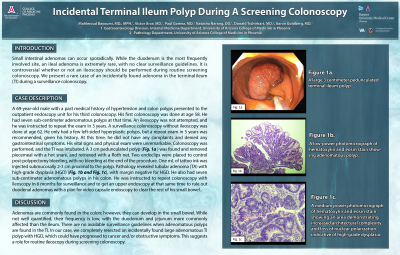Back


Poster Session E - Tuesday Afternoon
Category: Small Intestine
E0664 - Incidental Terminal Ileum Polyp During a Screening Colonoscopy
Tuesday, October 25, 2022
3:00 PM – 5:00 PM ET
Location: Crown Ballroom

Has Audio

Mahmoud Bayoumi, MD, MPH
University of Arizona College of Medicine
Phoenix, AZ
Presenting Author(s)
Mahmoud Bayoumi, MD, MPH1, Victor Arce, MD1, Paul Gomez, MD1, Natasha Narang, DO1, Donald Tschirhart, MD1, Aaron Goldberg, MD2
1University of Arizona College of Medicine, Phoenix, AZ; 2Phoenix VA, Phoenix, AZ
Introduction: Small intestinal adenomas can occur sporadically. While the duodenum is the most frequently involved site, an ileal adenoma is extremely rare, with no clear surveillance guidelines. It is controversial whether or not an ileoscopy should be performed during routine screening colonoscopy. We present a rare case of an incidentally found adenoma in the terminal ileum (TI) during a surveillance colonoscopy.
Case Description/Methods: A 69-year-old male with a past medical history of hypertension and colon polyps presented to the outpatient endoscopy unit for his third colonoscopy. His first colonoscopy was done at age 58. He had seven sub-centimeter adenomatous polyps at that time. An ileoscopy was not attempted, and he was instructed to repeat the exam in 3 years. A surveillance colonoscopy without ileoscopy was done at age 62. He only had a few left-sided hyperplastic polyps, but a repeat exam in 5 years was recommended, given his history. At this time, he did not have any complaints and denied any gastrointestinal symptoms. His vital signs and physical exam were unremarkable. Colonoscopy was performed, and the TI was intubated. A 3 cm pedunculated polyp (Fig 1a and 1b) was found and removed piecemeal with a hot snare, and retrieved with a Roth net. Two endoclips were placed to control post-polypectomy bleeding, with no bleeding at the end of the procedure. One mL of tattoo ink was injected submucosally 2-3 cm proximal to the polyp. Pathology revealed tubular adenoma (TA) with high-grade dysplasia (HGD) (Fig 1c), with margin negative for HGD. He also had seven sub-centimeter adenomatous polyps in his colon. He was instructed to repeat colonoscopy with ileoscopy in 6 months for surveillance and to get an upper endoscopy at that same time to rule out duodenal adenomas with a plan for video capsule endoscopy to clear the rest of his small bowel.
Discussion: Adenomas are commonly found in the colon; however, they can develop in the small bowel. While not well quantified, their frequency is low, with the duodenum and jejunum more commonly affected than the ileum. There are no available surveillance guidelines when adenomatous polyps are found in the TI. In our case, we completely resected an incidentally found large adenomatous TI polyp with HGD, which could have progressed to cancer and/or obstructive symptoms. This suggests a role for routine ileoscopy during screening colonoscopy.

Disclosures:
Mahmoud Bayoumi, MD, MPH1, Victor Arce, MD1, Paul Gomez, MD1, Natasha Narang, DO1, Donald Tschirhart, MD1, Aaron Goldberg, MD2. E0664 - Incidental Terminal Ileum Polyp During a Screening Colonoscopy, ACG 2022 Annual Scientific Meeting Abstracts. Charlotte, NC: American College of Gastroenterology.
1University of Arizona College of Medicine, Phoenix, AZ; 2Phoenix VA, Phoenix, AZ
Introduction: Small intestinal adenomas can occur sporadically. While the duodenum is the most frequently involved site, an ileal adenoma is extremely rare, with no clear surveillance guidelines. It is controversial whether or not an ileoscopy should be performed during routine screening colonoscopy. We present a rare case of an incidentally found adenoma in the terminal ileum (TI) during a surveillance colonoscopy.
Case Description/Methods: A 69-year-old male with a past medical history of hypertension and colon polyps presented to the outpatient endoscopy unit for his third colonoscopy. His first colonoscopy was done at age 58. He had seven sub-centimeter adenomatous polyps at that time. An ileoscopy was not attempted, and he was instructed to repeat the exam in 3 years. A surveillance colonoscopy without ileoscopy was done at age 62. He only had a few left-sided hyperplastic polyps, but a repeat exam in 5 years was recommended, given his history. At this time, he did not have any complaints and denied any gastrointestinal symptoms. His vital signs and physical exam were unremarkable. Colonoscopy was performed, and the TI was intubated. A 3 cm pedunculated polyp (Fig 1a and 1b) was found and removed piecemeal with a hot snare, and retrieved with a Roth net. Two endoclips were placed to control post-polypectomy bleeding, with no bleeding at the end of the procedure. One mL of tattoo ink was injected submucosally 2-3 cm proximal to the polyp. Pathology revealed tubular adenoma (TA) with high-grade dysplasia (HGD) (Fig 1c), with margin negative for HGD. He also had seven sub-centimeter adenomatous polyps in his colon. He was instructed to repeat colonoscopy with ileoscopy in 6 months for surveillance and to get an upper endoscopy at that same time to rule out duodenal adenomas with a plan for video capsule endoscopy to clear the rest of his small bowel.
Discussion: Adenomas are commonly found in the colon; however, they can develop in the small bowel. While not well quantified, their frequency is low, with the duodenum and jejunum more commonly affected than the ileum. There are no available surveillance guidelines when adenomatous polyps are found in the TI. In our case, we completely resected an incidentally found large adenomatous TI polyp with HGD, which could have progressed to cancer and/or obstructive symptoms. This suggests a role for routine ileoscopy during screening colonoscopy.

Figure: Figure 1a: A large 3 centimeter pedunculated terminal ileum polyp.
Figure 1b: A low-power photomicrograph of hematoxylin and eosin stain showing adenomatous polyp.
Figure 1c: A medium power photomicrograph of hematoxylin and eosin stain showing an area demonstrating increased architectural complexity and loss of nuclear polarization, indicative of high-grade dysplasia.
Figure 1b: A low-power photomicrograph of hematoxylin and eosin stain showing adenomatous polyp.
Figure 1c: A medium power photomicrograph of hematoxylin and eosin stain showing an area demonstrating increased architectural complexity and loss of nuclear polarization, indicative of high-grade dysplasia.
Disclosures:
Mahmoud Bayoumi indicated no relevant financial relationships.
Victor Arce indicated no relevant financial relationships.
Paul Gomez indicated no relevant financial relationships.
Natasha Narang indicated no relevant financial relationships.
Donald Tschirhart indicated no relevant financial relationships.
Aaron Goldberg indicated no relevant financial relationships.
Mahmoud Bayoumi, MD, MPH1, Victor Arce, MD1, Paul Gomez, MD1, Natasha Narang, DO1, Donald Tschirhart, MD1, Aaron Goldberg, MD2. E0664 - Incidental Terminal Ileum Polyp During a Screening Colonoscopy, ACG 2022 Annual Scientific Meeting Abstracts. Charlotte, NC: American College of Gastroenterology.
